Growing Mangoes from seeds can be fun for kids and experienced gardeners. Although it is very easy to grow Mangoes, you may face problems while trying to plant seeds from the Mangoes in the grocery store. You can plant Mangoes in the ground or in containers. Whether you want to plant in the ground or container, Mango trees need a hot sunny location and good drainage. Mango trees have specific requirements for healthy growth and producing quality fruits. These are common questions you face when growing Mango in your yard.
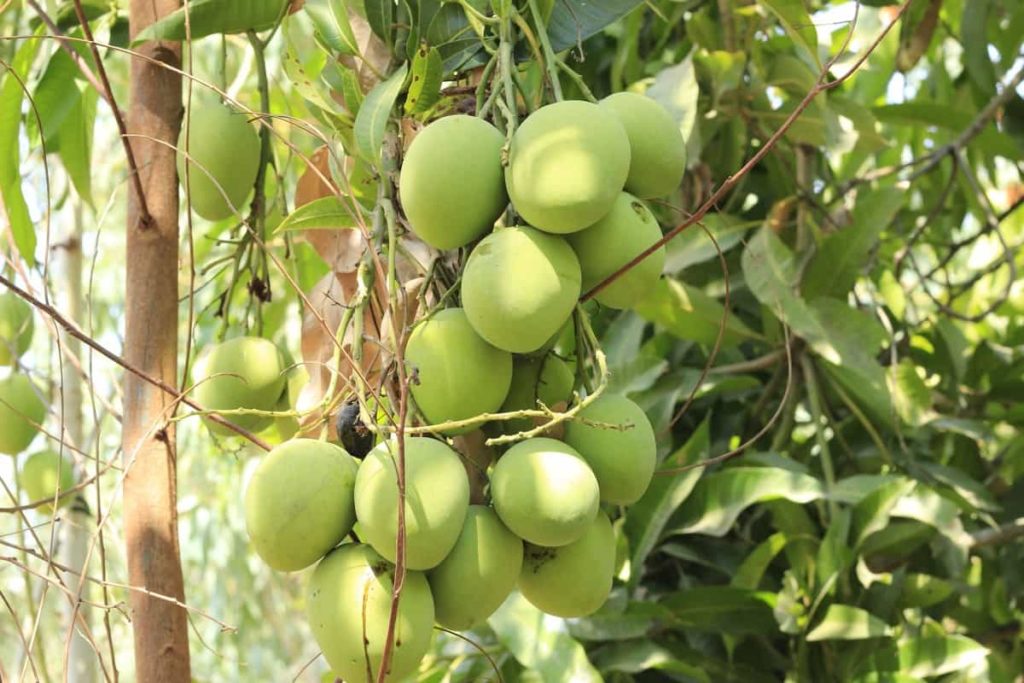
Growing Mangoes from seed to harvest
How long does it take to get Mangoes from a Mango seed?
- If you have a favorable climate for Mango plants, you can grow Mango trees and enjoy the sweet, vitamin-rich tropical fruit for years. With time and patience, it is easy to grow a Mango tree from a seed or small plant.
- Mango trees usually live well over 100 years and can produce fruit till the last stages of their life cycle. Mango trees planted with seeds will take about eight years to produce fruit, while planted from saplings will take up to 5 years to produce Mangoes.
- A seed-grown Mango tree will eventually produce fruit. It may or may not be the best quality fruit, but the tree will still eventually produce under the right conditions.
- Mango trees produce fruit ready for harvesting 100 to 150 days after flowering. The blooming season for Mangoes is between December and April, and the trees produce many flowers, sometimes in the thousands.
- Most fruits are ready to pick in June and July, but the specific harvest times vary depending on the variety. It takes 120 to 140 days to harvest a ripened Mango fruit from the fruit set. Dark green fruits begin to turn pale green to yellow at maturity.
Do you need more than one Mango tree?
- You don’t require two trees to get a fruit crop; you need parts of both male and female flowers. This is easier with Mangoes because each tree is monoecious, producing both male and female flowers.
- Mangoes are self-fertile, so a single tree will produce fruit without cross-pollination. The flowers are profuse, growing in panicles. Generally, Mango fruits grow at the end of a long, string-like stem, sometimes with two or more fruits in the branch.
Can I just plant a Mango seed?
- Mango seeds cannot dry out before planting. Wear gloves while handling seeds as latex sap inside can cause skin irritation. Cut the hard outer husk with sharp scissors and carefully remove it from the seed without damaging the seed inside.
- You can plant the seed on its edge with the curved edge facing downwards. Leave the top of the seed uncovered. If the seed is green in a few days, it is healthy and should grow well.
- If you’ve grown your seed in water or a paper towel, it’s a bit easier because your Mango seed roots go down, and the shoot points up above the soil.
- Within a few weeks, the Mango seeds should sprout. Water your plant with lukewarm water whenever you notice that the soil is a little bit dry.
Can Mango trees grow indoors?
- Yes, you can grow Mango trees in containers. They will often thrive on grown containers, especially dwarf varieties. Mangoes are from India, so they love hot temperatures. Large types make excellent shade trees and can grow up to 65 feet.
- You must remove the seed from the husk, soak it in a glass of water for the whole day, and then store it in a wet paper towel until it sprouts. If you store seeds and a damp paper towel somewhere hot and don’t let it dry, you’ll have a sprouting Mango tree within days to weeks.
- Seed-grown trees can take five to eight years. Trees growing indoors mostly depend on light, temperature, and fertilization.
What kind of soil do Mango trees like?
- Mangoes need the best drainage, so add a layer of broken pottery and crushed gravel under the pot. For a container-grown Mango tree, you’ll need light but highly nutritious potting soil. An example is 40% compost, 20% pumice, and 40% forest floor mulch.
- Organic matter-rich loamy, alluvial, well-drained, ventilated, and deep soils with a pH range of 5.5 to 7.5 are ideal for Mango cultivation.
- The Mango plant can thrive in almost any soil but needs well-drained soil in one place with protection from cold. Place your tree where it will get full sun to produce the best fruits. New Mango tree planting is done from late winter to early spring when the plant is not actively growing.
In case you missed it: How to Prepare the Soil for Mango Trees: Tips for Best Soil Mix, pH, and Compost
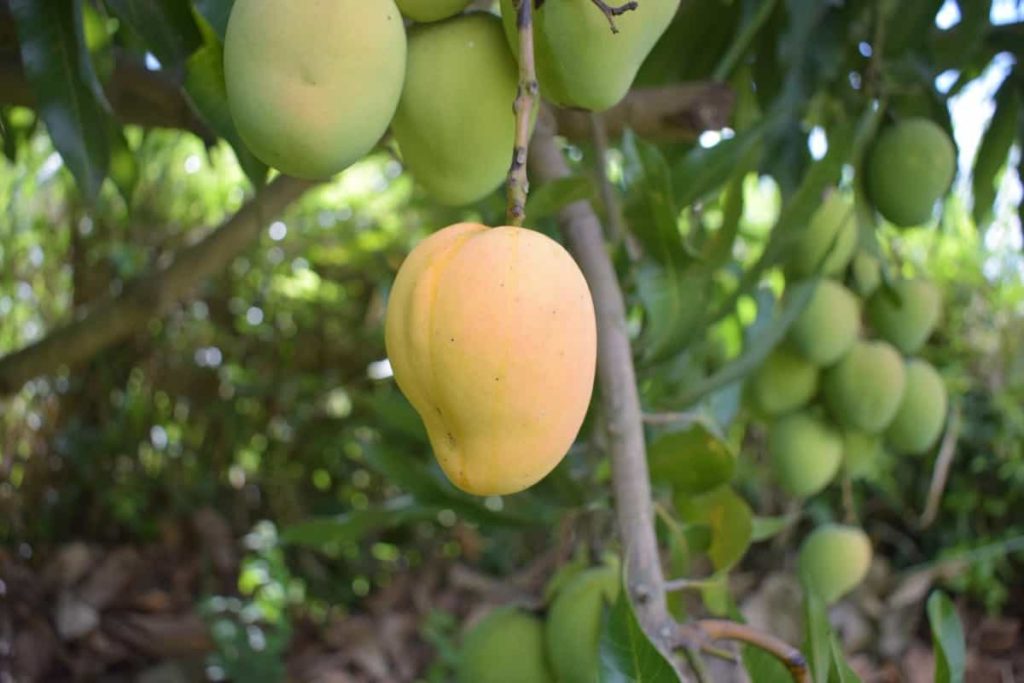
Why is my Mango tree not fruiting?
- The set of Mango fruits depends on several facts. Temperatures below 10°C will reduce the fruit set when flowering in spring. In addition, wet weather during flowering can result in anthracnose infections, which the fruits will not set.
- Check its location and exposure if your Mango isn’t bearing fruit. It may be that when you planted the tree, the place got the sun all day, but the nearby trees filled up and are now shadowing it as time passed. In this case, you’ll want to cut down neighboring trees to flood your Mangoes with light.
- The Mango tree needs full sun and should be planted in a shelter protected from wind and winter cold. Drought stress in the autumn and winter months, when the plant produces flowers, is desirable for fruiting.
How often should I water my Mango plant?
- The irrigation interval depends on the tree’s age, soil, and climate. The interval should be 2 to 6 days for the first six months after planting, 6 to 12 months old at weekly intervals, and 7 to 20 days until the plant attain a bearing age. The frequency of irrigation in light soil is higher than in heavy soils.
- Mango trees grow best in deep, well-drained soil that is slightly acidic. Mango trees tolerate dry conditions, waterlogging and moderate salinity.
- During long dry periods, newly planted and young Mango trees should be watered once a week. Irrigation frequency may decrease or stop after the rainy season arrives.
- Young Mango plants require 9 to 12 liters per plant water for better growth. 3 to 6 years, 6 to 10 years, 9 to 12 years, and fully grown trees require about 30 to 35 liters, 50 to 60 liters, 80 to 90 liters, and 120 liters per plant.
- Once the seeds grow, water them twice a week for the first three to four weeks. After that, mango trees need full sun and warm temperatures for continuous growth.
- The water needed will vary depending on rainfall, temperature, and soil moisture retention. In loamy soil, you may need to water once a week; in sandy soil, you may need to water twice a week.
How much room does a Mango tree need?
- You must consider the mature tree size when planting a Mango tree near home or other trees. Generally, large cultivars should be placed at a distance of 25 to 30 feet, while semi-dwarf and dwarf cultivars can be planted at a distance of 12 to 15 feet.
- The ideal distance of Mango trees in a garden is 10 x 10 meters. Around 82 trees per acre can be planted along this distance. In the ultra-high density plantation technique, Mangoes are planted at 3×2 meters with 674 plants per acre.
- Mango trees are deep-rooted plants that can become large specimens in the landscape.
How deep do you plant a Mango seed?
- You should make a small hole and place the seed inside the hole with an upward eye. You should dig a small hole about 8 inches deep. Push into the seed, downwards with the seed belly button. Keep the water well every day, or every other day, depending on the soil. After about 4 to 6 weeks, you will have Mango seedlings about 100 mm to 200 mm high.
Do Mango trees need fertilizer?
- Mango trees require fertilizer to produce good fruits and ensure the health of trees. Commercial production of Mangoes uses chemical fertilizers and organic forms such as compost. Mix a superphosphate fertilizer (0-45-0) with the soil to encourage the growth of strong roots when you first plant.
- Fertilize your young Mango tree once a month, starting from a month after summer arrives. Then, resume fertilizing once a month in the fall until winter begins. You can reduce fertilizing periods by 2 to 4 times annually after this first year.
- A higher nitrogen ratio benefits young Mango trees to help healthy leaves grow early in the season. Once they start bearing fruit, the need for nitrogen decreases. Once flowering and fruit start, Mango trees require an increasing ratio of phosphorus and potassium.
- The best time to fertilize Mangoes is in spring and autumn. Never fertilize during periods of extreme heat or during winter. Fertilizing your Mangoes increases vegetative growth and tropical fruit production. Use low nitrogen fertilizer with high phosphorus and potassium levels for established trees. Water your fertilizer in the ground for the best growth results.
In case you missed it: 14 Common Mango Tree/Plant Problems: How to Fix Them, Solutions, and Treatment
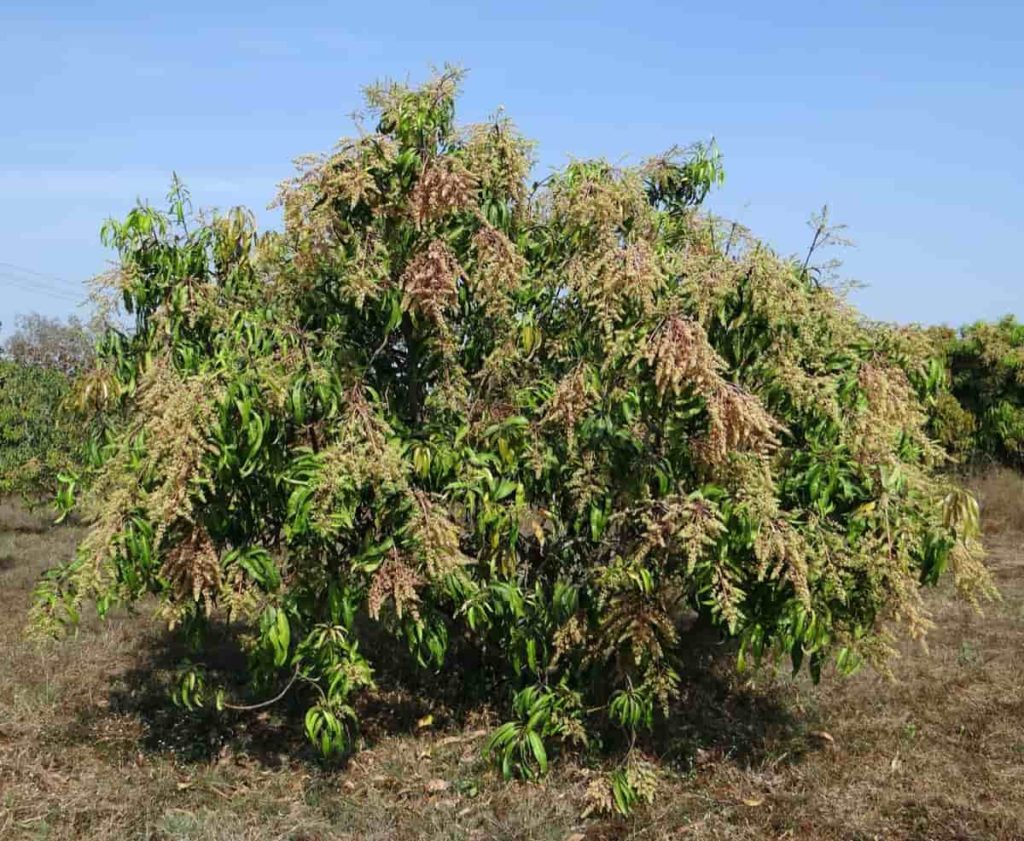
What month do Mango trees bear fruit?
- Mango trees produce fruit ready for harvesting 100 to 150 days after flowering. Most fruits are ready to pick in June and July, but the specific harvest times vary depending on the variety.
- Mango matures mainly during June-July, October-November, and January-February, but the tree can be counted on a large scale, bearing fruit throughout the year. The peak season runs from May to September, though you can find imported Mangoes in your market throughout the year.
Can you grow a Mango tree from a cutting?
- Mango tree propagation can be done by planting seeds or grafting Mango trees. However, trees take longer to produce fruit when propagated by seeds and are more challenging to manage than trees that have been grafted; thus, grafting Mango trees is the preferred method of propagation.
- To create a grafted Mango tree, allow the seedling stem to be about 1/4 inch thick before grafting it onto it. It will be six months and two years after the seeds are grown. Take a young cutting of an old tree and graft it directly onto a stem or seedling rootstock branch.
- Cut 6 to 8 inches of a young, thin branch from a healthy Mango tree, and remove the leaves on the bottom half. Also, remove any flowers or fruits. Cut and dip the hormone into rooting. You should plant the cutting in a small container with a potting mix without moist soil.
Is Epsom salt good for Mango trees?
- The four primary nutrients for Mango production are nitrogen (N), potassium (K), calcium (Ca), and boron (B). Therefore, understanding the interaction of these four nutrients is the key to good productivity and fruit quality in Mangoes.
- If your soil lacks it, give Mango trees at least one annual dose of magnesium for maximum fruit flavor. You should add magnesium to 100 square feet of soil annually in the form of 1 to 3 pounds of Epsom salt.
In case you missed it: Best Fertilizer for Mangosteen Tree: Organic, Compost, NPK, How and When to Apply

What is the best time to plant a Mango tree?
- The Mango plant can thrive in almost any soil but needs well-drained soil in one place with protection from cold. Place your tree where it will get full sun to produce the best fruits.
- The best time for planting a Mango tree is in the summer when it’s hot because they love the sun. It will help to start growing the Mango tree indoors and replant it outside after it sprouts.
- A well-developed root system is essential to ensure the survival of trees from October until the onset of the wet season. Therefore, planting in January/February is another good time for plantation and should coincide with the arrival of monsoon rains.
How do you maintain a Mango farm?
- Mango cultivation requires deep and sandy loam soil, but heavy black cotton and alkaline soil should be ignored or avoided. The soil pH of Mango cultivation should be 5.5 to 7.5. It is usually planted in rainy areas in July-August and should be irrigated in February-March.
- The Mango farm should be irrigated at intervals of two to three days in the first year of your Mango cultivation business. However, around two irrigations are required at the stage when they start bearing fruit. You must water the fruit plant at intervals of 10 to 15 days.
Do Mango trees need a lot of sun?
- Mango trees require full sunlight, which means at least eight hours of direct sunlight on most days. If they do not get enough light, their flower and fruit production will be damaged. A south-facing window inside the house can work, but it’s best to move the pot out as much as possible for full exposure to sunlight.
- Once the seeds grow, water them twice a week for the first three to four weeks. After that, mango trees need full sun and warm temperatures for continuous growth.
Should you prune Mango trees?
- You don’t need to prune Mango trees every year. Mango trees are terminal bearers, which means they flower from the ends of branches and will only bloom on mature wood.
- Allow all shoots to grow into branches longer than 1meter after the initial cut. These are then cut to about a meter in length, giving you a nice strong branch to support the growing tree. Once again, ensuring that the cut is below the ring of buds is essential so only three shoots will be ready.
- The best time to prune Mango trees is immediately after the fruits are harvested and not after mid-December. First, remove dead branches crossing together or touching the ground.
In case you missed it: How to Grow Mangosteens from Seeds: At Home, In Pots, and Backyard
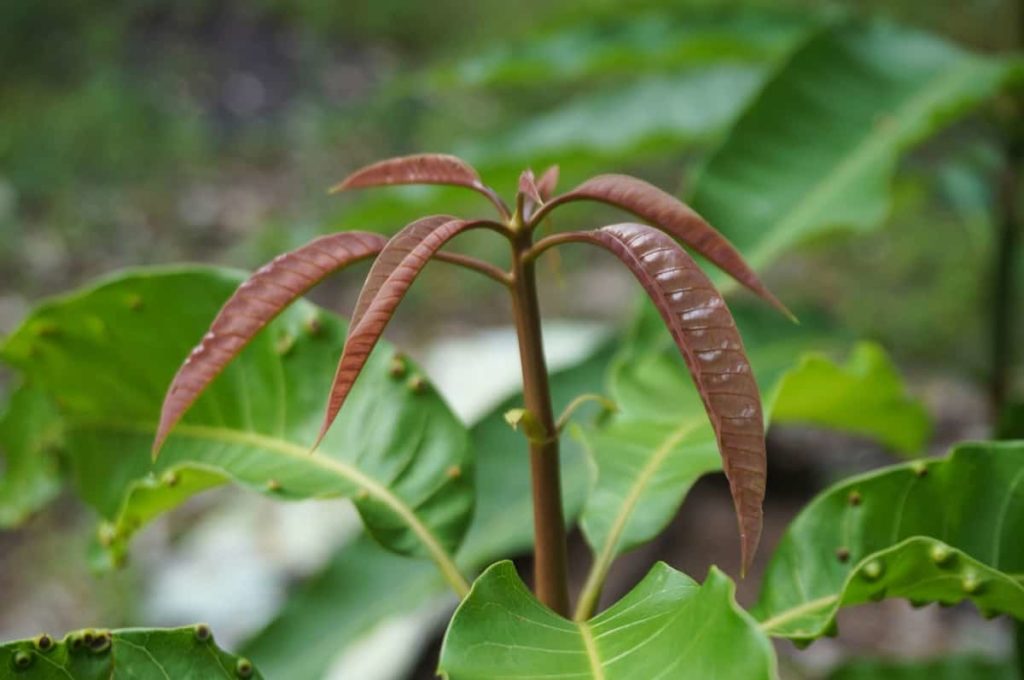
How many times can you harvest Mango in a year?
- Mango trees are broad-canopied evergreens that make up the best shade trees. A healthy tree in a suitable climate and location can produce large crops of juicy Mangoes yearly.
- Mangoes are picked up by hand four times during the harvesting season. The fruit is harvested at the so-called mature green stage and should not be confused with ripening.
- While Mangoes ripen on the tree, Mango harvesting usually occurs when strong but mature. Depending on different climatic conditions, it can happen three to five months from the time they flower.
How can I speed up my Mango growth?
- Nutrition can be a problem if the Mango tree is not growing. You should fertilize young trees once a month during their first year. This application can be reduced by 3 to 4 times annually for more mature trees.
- Provide adequate moisture to encourage growth. Mango trees need equally moist soil to produce high-quality fruits. If weather conditions do not provide enough moisture, a soft young Mango tree should be watered outdoors for two to three days.
- The Mango tree is taken care of like any fruit tree. Water the trees deeply to irrigate the long taproot. You should allow the top surface of the soil to dry to a depth of several inches before re-watering. Stop irrigation for two months before flowering and then resume once fruits begin to produce.
Will Mangoes ripen if picked green?
- It will still ripen if you pick it from the tree too early, but it may not taste as good as if it is left to ripen on the tree for too long.
- Mangoes are among the varieties of fruits that continue to ripen after picking them. Raw Mangoes produce their ethylene gas which helps them cook. This ethylene gas can speed up the ripening process to reach golden yellow sooner.
How many mangoes does a mango tree produce?
- The yield increases to probably 10 to 20 fruits per tree at the age of 3 to 4 years, 50 to 75 fruits in later years, and about 500 fruits in its tenth year. A tree between the ages of 20 and 40 bears 1,000 to 3,000 fruits in an “on” year.
- The yield of a Mango tree depends on its size, the distance of the trees, and your management.
In case you missed it: Fertilizer Management in Mango: Homemade, Organic, Compost, Liquid, and Schedule
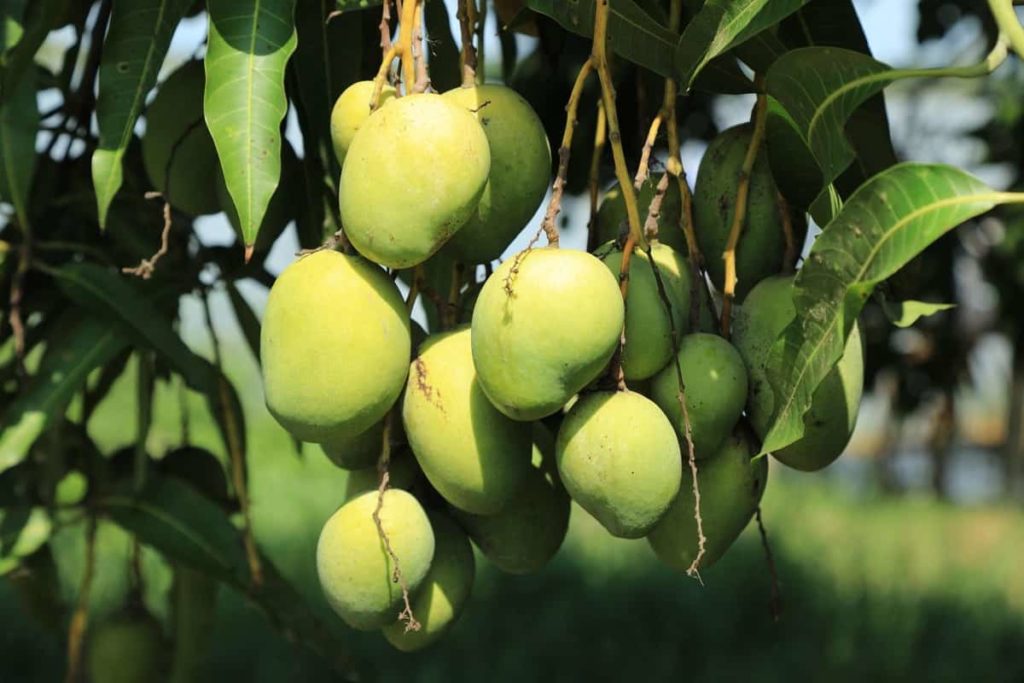
Conclusion
You should plant Mango trees in the spring which are usually growing faster. However, keeping the indoor Mango tree alive long enough to mature and bear fruit can be challenging. Also, note that juice, bark, or fruit skin can harm people. Based on where you are in the world, there are many varieties of Mango trees that you can choose to plant and add to your home garden. The Mango tree will not only become an attractive evergreen tree with shade, but you will also grow amazing Mango fruits to enjoy in the summer.
- How to Grow Tomatoes Organically at Home: A Comprehensive Guide
- Organic Gardening on a Budget: Low-Cost Methods and Materials
- Gongura Seed Germination and Planting Methods
- Cabbage Seed Germination and Selection
- Broccoli Seed Germination and Selection
- Asparagus Seed Germination and Variety Selection
- Seasonal Flower Gardening: Best Practices for Spring, Summer, Fall, and Winter
- How to Grow Hibiscus from Flower
- Plantation Ideas for Home Decoration: A Beginners Guide
- Flower Garden Designs and Layouts for Beginners
- Planting and Spacing Techniques in Papaya: A Beginner’s Guide
- Growing Gold: Essential Techniques for Planting Pineapples
- How to Make Kalanchoe Plant Bushy: Home Remedies and Solutions
- 11 Reasons Why Your Gardenia is Not Blooming: Home Remedies and Solutions
- Eco Elegance: The Guide to Designing a Drought-Tolerant Landscape
- Gardening on a Slope: Strategies for Hillside Landscaping
- Nourish and Flourish: Top Organic Mulches for Thriving House Plants
- Everything You Want to Know about Indian Mogra Flower: Discover Uses and Growing
- Green Thumb Success: Expert Tips for Cultivating Greenhouse Pumpkins All Year Round
- Maximize Growth & Flavor: The Ultimate Guide to Companion Planting in Herb Gardens
- How to Control Rhododendron Problems Naturally: Home Remedies and Organic Ways to Fix Them
- Natural Magic: The Remarkable Benefits of Cinnamon for Plants
- Best Steps to Revive Dying Tulip with Natural and Organic Treatment
- 10 Reasons Why Your Angel Trumpet is Not Blooming: Remedies and Treatment
- How to Fix Periwinkle Leaf and Flower-Related Problems: Natural Remedies and Solutions
- How to Fix Zinnias Leaf and Flower Problems: Discover Natural and Home Remedies
- Organic Steps to Induce Lemon Tree Flowers: A Comprehensive Guide
- Bloom Booster: Crafting the Perfect Homemade Bougainvillea Fertilizer
- Optimizing Growth: A Guide to Applying NPK Fertilizer for Potted Plants
- 10 Best Homemade Fertilizers for Rubber Plant: DIY Recipes and Application Method
- How to Boost Female Pumpkin Flowers: Effective Steps for More Flowers and High Yields
- Transform Your Indoor Garden: Top Benefits of Pink Salt for Houseplants
- 10 Best Homemade Fertilizers for Peacock Plants (Calathea): Easy DIY Guide
- Unlock Blooms: 9 Reasons Why Your Potted Chrysanthemum is Not Blooming
- 8 Reasons Why Your Potted Hibiscus is Not Blooming: Fix it with Simple Solutions
- Unlock Blooms: 9 Key Reasons Your Potted Frangipani Won’t Flower